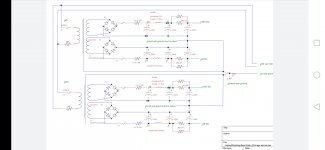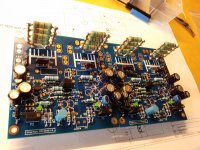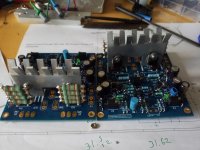Hi Vishal. Can you please share your Power Supply Schematic. I can't figure out the wiring done
Very nice vishalk.
But I'm more curious as to the sound?, I bought kubota regulated boards and will try a hiraga, I reasontly finished a jlh amp and heard praises for hiraga, I will be using a capacitance multiplier instead of hundreds of thousands of uf.
But I'm more curious as to the sound?, I bought kubota regulated boards and will try a hiraga, I reasontly finished a jlh amp and heard praises for hiraga, I will be using a capacitance multiplier instead of hundreds of thousands of uf.
Hi again.
I'm currently awaiting the hiraga kubota boards offered by Jim's audio, it's stated in the advert that after paying they will send schematic and bom on mail, didn't happen, send two emails, but no response,
Would any of you have those files, and share them, would like to get started on gathering parts and transistor equivalents.
I'm currently awaiting the hiraga kubota boards offered by Jim's audio, it's stated in the advert that after paying they will send schematic and bom on mail, didn't happen, send two emails, but no response,
Would any of you have those files, and share them, would like to get started on gathering parts and transistor equivalents.
Why may I ask? Seems to be very good with jlh amplifier
I have used the Cap multiplier with this Amp. But when i used the actual capacitors, the amp was on a complete different level. There was a night and day difference in the lower frequencies. "The Bass region improved a lot"
Hello,
Probably has been said before but it doesnt hurt doing it one more time.
When Hiraga published the articles about these amps lots of attention went into finding the right " mix '' of parts. In those days the kits being sold in Paris had the now famous Shinkoh 0,5 resistors, big value caps made by Sic Safco, CEF, double C core transformer and a few transistors that are hard or impossible to get nowadays.
I remember when the driver transistors were not available anymore the people in Paris found new ones and if i remember well made some adjustments to other parts.
I think without the right equipment and experience one cannot build a Hiraga amp with modern parts which will be better than the original one. If it does happen it will be jus
t being lucky.
Greetings, Eduard
Probably has been said before but it doesnt hurt doing it one more time.
When Hiraga published the articles about these amps lots of attention went into finding the right " mix '' of parts. In those days the kits being sold in Paris had the now famous Shinkoh 0,5 resistors, big value caps made by Sic Safco, CEF, double C core transformer and a few transistors that are hard or impossible to get nowadays.
I remember when the driver transistors were not available anymore the people in Paris found new ones and if i remember well made some adjustments to other parts.
I think without the right equipment and experience one cannot build a Hiraga amp with modern parts which will be better than the original one. If it does happen it will be jus
t being lucky.
Greetings, Eduard
Sadik thanks for your explanation, but I will still give it a try, and maybe a a/b test, capacitance multiplier verses lots of uf, maybe I can borrow the cap bank the us military used for their railgun tests🙂
The Hiraga adventure has begun, I followed advices here and used paralelled metal oxide ballast resistors, I have a completed ripple eater, and 0.8 farad 35v capacitors plus chokes, and lastly dual 24 volt 40 amp amps, I will give all 3 power supplys a go and see which one performs best, my guess is the clc supply.
Theres loads of informative stuff in this thread, I'll will read through it thouroughly.
Theres loads of informative stuff in this thread, I'll will read through it thouroughly.
Attachments
Further progress, I was unable to find suitable heatsinks for the driver section, but one hours work with a hacksaw cured that, I hope my homemade heatsink provides enough cooling, time will tell, I made them in one piece so that they are thermally the same, Jim's Bom list says mje15034/35, but I've heard praises on the 2sa1837-2sc4793 from Toshiba, so I installed them instead, they are leg compatible with mje.
For output I have a stash of old 2sa117/2sc2608 to-3 any thoughts on if they can work well in a hiraga ?
For output I have a stash of old 2sa117/2sc2608 to-3 any thoughts on if they can work well in a hiraga ?
Attachments
Hi,@Eduard,
Sorry but i disagree with you. I've built this amp as well as the le monstre using original transistors (yes i still have them). I've also build the le classe with a very modest psu and parts (2n3055 etc). The monstre is difficult to do right, mine could sing or squeel depending of the hour of the day or the weather for my part.
The le classe is hard to get sounding wrong. It's a friendly sounding amp with special qualities. I think that with the build Vishalk has made, he is a good way along to what was intended. Remember, Hiraga took an existing circuit and modded the hell out of it to get it at it's best.
anyway, i like Vishalk has finally finished the build. It looks great and sounds as good as well i 've been told.
regards,
Joris
Sorry but i disagree with you. I've built this amp as well as the le monstre using original transistors (yes i still have them). I've also build the le classe with a very modest psu and parts (2n3055 etc). The monstre is difficult to do right, mine could sing or squeel depending of the hour of the day or the weather for my part.
The le classe is hard to get sounding wrong. It's a friendly sounding amp with special qualities. I think that with the build Vishalk has made, he is a good way along to what was intended. Remember, Hiraga took an existing circuit and modded the hell out of it to get it at it's best.
anyway, i like Vishalk has finally finished the build. It looks great and sounds as good as well i 've been told.
regards,
Joris
Hello,
Probably has been said before but it doesnt hurt doing it one more time.
When Hiraga published the articles about these amps lots of attention went into finding the right " mix '' of parts. In those days the kits being sold in Paris had the now famous Shinkoh 0,5 resistors, big value caps made by Sic Safco, CEF, double C core transformer and a few transistors that are hard or impossible to get nowadays.
I remember when the driver transistors were not available anymore the people in Paris found new ones and if i remember well made some adjustments to other parts.
I think without the right equipment and experience one cannot build a Hiraga amp with modern parts which will be better than the original one. If it does happen it will be jus
t being lucky.
Greetings, Eduard
Further progress, I was unable to find suitable heatsinks for the driver section, but one hours work with a hacksaw cured that, I hope my homemade heatsink provides enough cooling, time will tell, I made them in one piece so that they are thermally the same, Jim's Bom list says mje15034/35, but I've heard praises on the 2sa1837-2sc4793 from Toshiba, so I installed them instead, they are leg compatible with mje.
For output I have a stash of old 2sa117/2sc2608 to-3 any thoughts on if they can work well in a hiraga ?
i just cut small computer chip heatsinks and glued them on the driver transistors on my 30w Hiraga. That works fine.
Thanks for reply ralf, now I'm sure that my heatsink is adequate, you used the same boards, are you satisfied with the end result, do they perform well, and how are their pssr, are they less prone to hum compared to a standard hiraga
i used selfmade boards, slighly different than the original french boards. i use same transistors as Dan did. All original except of power transistors, Toshibas 2sc5200...
2 monos, with giant heasinks and fan support.
CRCRC psu with 1 F each monoblock, made of hundreds of 2700uF caps.
2 Ampere bias. gets handwarm only.
how to get a pic with preview in here?
2 monos, with giant heasinks and fan support.
CRCRC psu with 1 F each monoblock, made of hundreds of 2700uF caps.
2 Ampere bias. gets handwarm only.
how to get a pic with preview in here?
Hello,
When i built mine 35 years ago i also found out that it is a good thing to mount the two drivers ( isolated) on the same heatsink. IF i remember well changing the temperature of one of the drivers resulted in a higher DC offset.
Also a good idea to replace the two 1K8 resistors close to the drivers by ones having some extra power rating. Originally i used the Shinkoh 0,5 watt changed them into Allen Bradley 2W.
I do remember asking Lundahl about using the chokes for a power amp when my friend in Vietnam wanted to use it for a single ended Nelson Pass design. There you can use it like Lundahl tells you in their PDF as serial connection for improved common mode rejection. There the current through both the '' coils '' on the same iron will be identical.
BUT what if you use it in a symmetrical power supply? With one coil in the positive side and the other in the negative side? So i asked Per Lundahl again a few weeks ago because a friend of mine will use the LL2771 in his Hiraga.Here the answer:
Hello Ed,
For optimal performance yes, the current through the two coils should be the same.
But the fact that something is not 100% right does not mean that it has to be wrong...
- Per Lundahl
Now the 1000$ questions.
Is the current the same?
Should both positive and negative wires coming from the first cap be connected to the '' dot side '' of the winding or should one be in reverse?
Greetings, Eduard
When i built mine 35 years ago i also found out that it is a good thing to mount the two drivers ( isolated) on the same heatsink. IF i remember well changing the temperature of one of the drivers resulted in a higher DC offset.
Also a good idea to replace the two 1K8 resistors close to the drivers by ones having some extra power rating. Originally i used the Shinkoh 0,5 watt changed them into Allen Bradley 2W.
I do remember asking Lundahl about using the chokes for a power amp when my friend in Vietnam wanted to use it for a single ended Nelson Pass design. There you can use it like Lundahl tells you in their PDF as serial connection for improved common mode rejection. There the current through both the '' coils '' on the same iron will be identical.
BUT what if you use it in a symmetrical power supply? With one coil in the positive side and the other in the negative side? So i asked Per Lundahl again a few weeks ago because a friend of mine will use the LL2771 in his Hiraga.Here the answer:
Hello Ed,
For optimal performance yes, the current through the two coils should be the same.
But the fact that something is not 100% right does not mean that it has to be wrong...
- Per Lundahl
Now the 1000$ questions.
Is the current the same?
Should both positive and negative wires coming from the first cap be connected to the '' dot side '' of the winding or should one be in reverse?
Greetings, Eduard
Good question Eduard, do you think it matters?
Ralf that sounds like an impressive build, I would like to see it, it's always nice to get some inspiration, I have not yet figured out have the chassis is going to be, but I think I will keep it close to a open hiraga, the one looking like a tube amp, with exposed capacitors and toroids.
Ralf that sounds like an impressive build, I would like to see it, it's always nice to get some inspiration, I have not yet figured out have the chassis is going to be, but I think I will keep it close to a open hiraga, the one looking like a tube amp, with exposed capacitors and toroids.
Regarding output transistors, as mentioned I have some 2sc2608 2sa1117.
Specs are really nice similar to mjl21193 mjl21194, and also to3 for better heat disposal,
But I have been unable to find COB values for 2608 1117, as i have been reading on this thread low COB matters, is there a way to find that missing spec?
Specs are really nice similar to mjl21193 mjl21194, and also to3 for better heat disposal,
But I have been unable to find COB values for 2608 1117, as i have been reading on this thread low COB matters, is there a way to find that missing spec?
- Home
- Amplifiers
- Solid State
- Jean Hiraga Super Class A 30w Build


